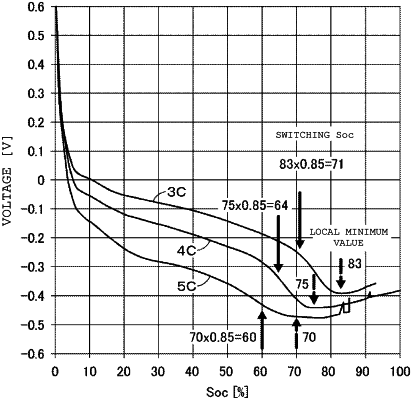| CPC H02J 7/0048 (2020.01) [B60L 50/60 (2019.02); B60L 53/62 (2019.02); B60L 58/12 (2019.02); H01M 10/44 (2013.01); H01M 10/48 (2013.01); H02J 7/007 (2013.01); H02J 7/0071 (2020.01); H02J 7/00712 (2020.01); H02J 7/007182 (2020.01); H02J 7/007184 (2020.01); B60K 6/28 (2013.01); B60Y 2200/91 (2013.01); B60Y 2200/92 (2013.01); B60Y 2300/91 (2013.01); B60Y 2400/112 (2013.01)] | 5 Claims |

|
1. A charging device, comprising:
a voltage detection unit for detecting a secondary battery voltage;
a current detection unit for detecting a secondary battery current;
a control unit receiving a detection signal of the voltage detection unit and the current detection unit to control charging voltage/charging current; and
a DC/DC converter that is controlled by the control unit to supply current to the secondary battery,
wherein the charging device switches to a (n+1)-th charging rate from a n-th charging rate when constant current charging is performed on a secondary battery at the n-th charging rate, at a state of charge (SOC) of the secondary battery, of 0.8 times or more and 0.9 times or less of an SOC at which a voltage local minimum value appears according to an environmental temperature at start of charging when an experimental battery having a same type of negative electrode and electrolytic solution as the secondary battery and metallic lithium is charged at the n-th charging rate,
wherein the (n+1)-th charging rate is lower than the n-th charging rate, and n is a natural number, and
wherein, when the SOC of the secondary battery is 80% or more of the SOC of the experimental battery at which the voltage local minimum value appears, the charging device charges at the n-th charging rate until full charging without switching from the n-th charging rate to the (n+1)-th charging rate.
|